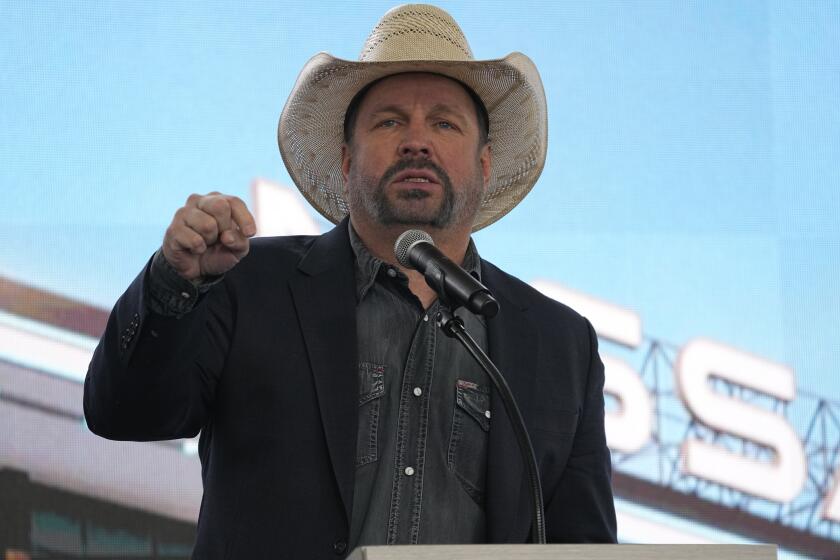Sounds for Today or Bygone Paris
In the music industry, a long delay between a first and second album is often seen as damaging beyond repair, raising the prospects of being forgotten at best, or at least losing momentum.
But in the case of Scottish composer and electronic musician Craig Armstrong, the four years between “The Space Between Us” in 1998 and his imminent follow-up, “As if to Nothing,” may well be the best thing that could have happened to him.
During the hiatus, Armstrong took on the role of a musical lifetime: writing and performing the score to Baz Luhrmann’s Oscar-winning “Moulin Rouge.” Although the film’s score wasn’t eligible for an Oscar last week because less than 50% of the music was original, Armstrong won a Golden Globe and an AFI Award for his ambitious, romantic score.
With Hollywood relying more and more on electronic musicians for scores (Paul Oakenfold for “Swordfish,” BT on “The Fast and the Furious”), Armstrong may well be the perfect modern composer.
He’s one of the leading figures in the dance music world. His production, arranging and composition skills have been used by such mainstream supporters of electronic music as Madonna, Bjork, Pet Shop Boys and U2, as well as electronic star William Orbit.
In addition to his electronic background, including work with the seminal Bristol, England, group Massive Attack, Armstrong studied at London’s Royal Academy of Music. The combination of old and new sensibilities has made him one of the most sought-after new composers in Hollywood. His score credits include “Mission: Impossible,” “Bone Collector,” “Best Laid Plans” and Luhrmann’s “William Shakespeare’s Romeo + Juliet.”
“He learned the fundamentals of telling stories through music on ‘Romeo + Juliet,’” Luhrmann says of his collaborator. “He now actually is advancing the cause of telling stories through music. So working with him now is an equal relationship.”
Says Armstrong, “I met my agent today, and I can get a film every month. But I told him if I only do one film a year every two years as long as it’s really special and I can really connect to it, I’ll be happy.”
That’s in large part because he wants to avoid a repeat of that delay between his albums. Although when the atmospheric new album, which features appearances by Bono, Scottish rock band Mogwai and former Lemonheads singer Evan Dando, is released on April 16, the “Moulin Rouge” connection will be a big part of Astralwerks Records’ marketing campaign.
It’s all heady stuff for Armstrong, 43, a family man who still lives in his hometown of Glasgow and didn’t decide to make his living with music until he was in his 30s. At a time when DJs and electronic musicians are becoming stars, his wants are modest.
“I am one of those boring people who, if I could just do the records, people bought them and I could go back in the studio and make another one, I’d be quite happy.”
Armstrong, who in his 20s supported himself by doing score work for a Glasgow theater, was discovered within music circles in the ‘90s, when he joined forces with the English production team of Marcus DeVries, later the music supervisor for “Moulin Rouge,” and Nelle Hooper. After being recruited by Massive Attack to provide orchestral and string arrangements for its work, he was signed to the influential trip-hop group’s Melankolic label, on which he released “The Space Between Us.”
Although Armstrong credits Luhrmann and DeVries with much of the sound of “Moulin Rouge,” fans of the film who come to “As if to Nothing” will find many familiar elements.
“Now that I’m getting into my mid-40s, everything I do has a sound now,” he says. “I try not to divide my music and say, ‘I’ll write a piece of film music here, or a classical piece, or a track from my album here.’ I’m going in the same direction musically in all things.”
The new record is a bit of a departure from “The Space Between Us.” Armstrong calls it a more “emotionally concise” album, and it offers some grand pieces, particularly the finale, “Choral Ending,” and “Snow,” with English singer David McAlmont. But the dense “Ruthless Gravity” and the minimalist “Hymn 2,” a collaboration with electronic act Photek, are more the norm.
“I tend to like music that has that kind of cinemascope, like [composer Angelo] Badalamenti, who uses a lot of open spaces,” he says. “I’m quite influenced by West Coast music in America. I’m a huge Chet Baker and Burt Bacharach fan, all the West Coast movie men who don’t use a lot of notes.”
Although Armstrong worked on the record during the year and a half he spent on “Moulin Rouge,” he says the music from the film didn’t really influence him.
However, the freedom Luhrmann gave him did.
“Although Baz has got a very strict vision of what he wants, you can do anything within that vision,” he says. “What he taught me is you give people you work with freedom.... If you work with David McAlmont or Photek, the first thing you say is, ‘Well, what do you want to do?’”
Perhaps the most striking collaboration is with Dando on the dramatic love song “Wake Up in New York.”
“With Evan it’s just emotion,” Armstrong says. “I’m not very good at explaining music, but there’s something he does that’s magic. When the mike goes on in ‘Wake Up in New York,’ you’re just there immediately.”
Armstrong was hesitant to include the track because of the Sept. 11 tragedies, but he seems pleased with the idea that the song, in the context of the record, conveys a message of healing.
“I wanted to put something on this album, like the song ‘Let It Be Love,’ that no matter what the journey is, you say something very positive at the end.”
He pauses.
“Maybe that’s a connection between the two projects. ‘Moulin Rouge’ and this album are just about humanity and life.”
*
More to Read
The biggest entertainment stories
Get our big stories about Hollywood, film, television, music, arts, culture and more right in your inbox as soon as they publish.
You may occasionally receive promotional content from the Los Angeles Times.










